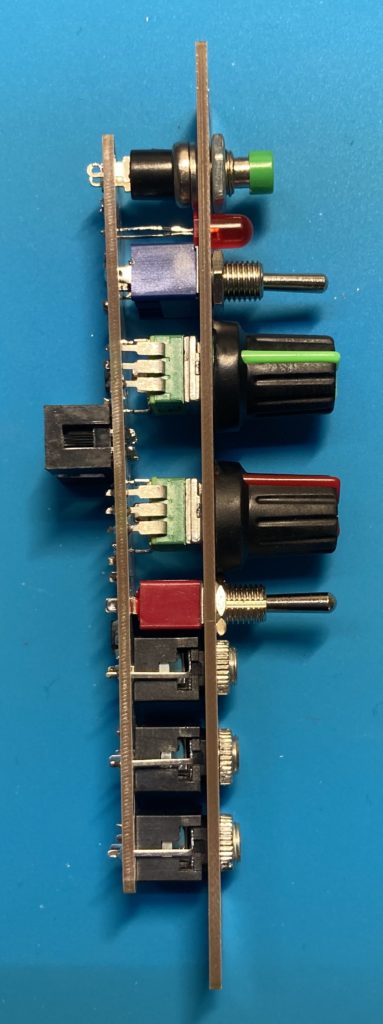The AD/AR is a Eurorack envelope generator based on a 555 timer. It’s simple to use, cheap and easy to build.
The AD/AR is named after the primary feature: a switch between attack-decay mode and attack-release mode. Your envelope can be held high with a gate input, or switch it to engage a gate-to-trigger conversion circuit so your gates become plucky stabs.
Specs: 4HP wide, and only 23mm deep. Power draw is only 12 mA on the +12V and 5mA on the -12V.


Build Guide PDF is a step by step and Bill of Materials. And also an interactive html ‘ibom’.
This circuit, like every circuit, is a modification of stuff I learned from others online.
The button on top is a manual gate/trig so you can test or play it directly. The gate/trig switch on top has a center position for mute, so you can smoothly deactivate parts of your music without clipping any notes. Outputs are available as 0->10V in both positive and negative for modulating anything. It’s buffered but has a 1kOhm output limiter.
The length of the envelope is set with two knobs, ranging from 0 to ‘full’. The Full length is defined by how long it takes to fill or empty some capacitors. The module uses four 10uF caps for this, two in parallel for a 20uF effective, and two in series for a 5uF effective. The fast envelope has a max time of about 4 seconds. The slow envelope is about double that; 4 seconds lit and ten seconds overall. When building your own you could replace these with other values.
| Kit Type | Price | Notes | |
| PCB/Panel Set | $20 | ||
| Full parts kit (incl PCB) | $65 | ||
| Built and Tested | $115 |
NOTE: SMT0805 construction means you need good eyesight and tweezers to build this kit. It’s doable by hand if you have some soldering experience already. The chips are SOIC with a 1.27mm pitch so you will need the soldering accoutrements: copper braid and/or fluid flux to keep the pins apart before powering the circuit. These tools are not included with the kit.
Building Tips
In v1.0 the pads for the diodes are too small, so it’s tricky to get them soldered down. Turn it or lift it a little and you can solder bridge from the pad to the diode.
The lock washers for the switches may interfere with neighboring components on the faceplate. It’s okay to remove or go without the lock washers. You also don’t need to use both nuts or the flat orientation washer under each switch.
The placement of the lock washer on the button doesn’t seem to matter.
Check that the transistor is face-up. You should be able to see some text on the top.
The 555 installs with pin 1 top right, which results in the text being upside down, since pin1 is normally lower left when the text is readable.
Troubleshooting Tips
After building the third unit, I found it not to activate: quite dead. Found a lifted leg, one pin of the 555 I missed soldering. Check your solder joints! Easy fix. Same if it seems stuck on, check your solder.
In the v1.0 kit the 3-way switch is a little bit larger than the holes drilled for it. I have filed down the switch legs so it will fit for you. In v1.1 I have increased the size of the mounting holes, so more cheap switches will fit without such fiddling.
Modifications
The switch for fast or slow range envelopes is picking which set of integrator capacitors to use. By default we have two 10uF in parallel for a 20uF effective “Long/Slow” and two 10uF in series for a 5uF effective “Short/Fast”. You can change these to taste.
To change the fast mode, omit C5&7 and put something between 1-10uF across their rightmost pads.
If using a polarized electrolytic, put the negative on the upper pad (right of C5).
To change the slow mode, omit C6&8 and put something above 10uF across either C6 or C8, leaving the other empty. If using a polarized electrolytic, put the negative on the right pad, which is grounded.
Theoretically you could use a gigantic millifarad device here for very long envelopes, up to the limit their internal leakage prevents envelope completion. In a test bridging a 2200uF across the existing 2x10uF (sum=2220uF) and the knobs set to just 30%, the envelope stayed open for more than five minutes.